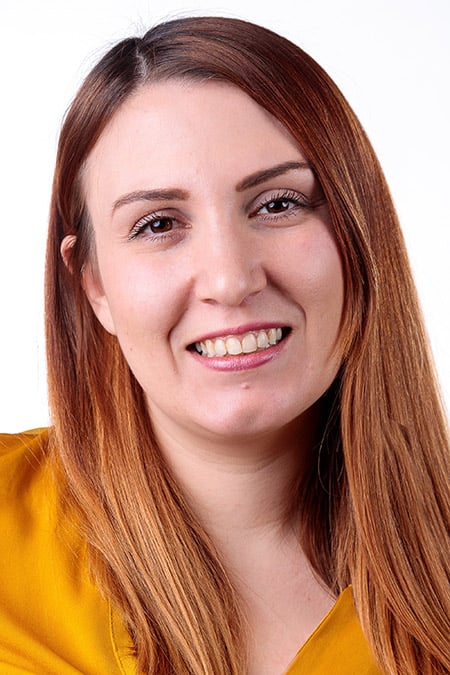The importance of assistive technology in feeding
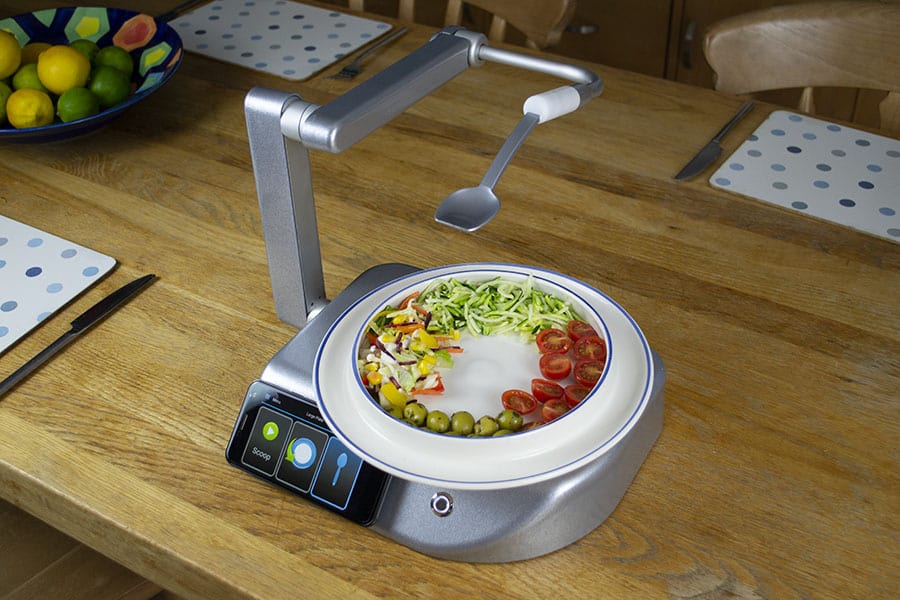
As humans, we have core basic needs that should be met to live a healthy and happy life. These include food, water, sleep, shelter, social interaction and, lastly, a sense of purpose.
Stemming from empirical research I have completed, the most important elements to survive are food and water, forming the top outcome in every paper which has also come out on top of every list.
Nutrition is equally as important as the air that we breathe. As human beings, we have a range of different abilities depending on our physical and mental capacity, therefore, some people may require physical, medical or technological assistance to achieve this basic need.
Unfortunately, assistive technology isn’t always readily available. Instead, for those that need it, commonly, a care plan will be put in place where the client will be fed by their carer. Some people prefer this method of eating, however, others do not and feel their basic right to feed themselves has been taken away. This can transpire to malnutrition, reduced social interaction and a lost sense of purpose.
The reason for not having this technology available is down to one of two things: knowledge of the various equipment available and access to funding. I hope to explain and raise awareness of some options that could potentially reduce care package costs, offer independence to the user and even increase physical and mental wellbeing.
Assistive technology in feeding can range from:
Manual aids: Adapted cutlery, gripping aids, height-adjustable tables, manual mobile arm supports and spring/hydraulic or dampened assisted feeders.
These allow the user – who may have limited strength, fatigue, reduced grip, joint pain, poor co-ordination or tremor – to self-feed with the support of a non-electrical aid.
Electrical and robotic: Battery-operated cutlery; power-assisted feeding devices such as plate turners, motorised spoon arms or power assisted arm supports; computer-programmed robotic feeding devices and arms; and exoskeletal upper limb technology.
Power-assisted devices are predominantly controlled via switches or a joystick to control components for users with low tone, high tone, uncontrolled movement, extreme fatigue and/or rapid deterioration in strength in their upper limbs to raise their own or a robotic arm (with a spoon/fork attachment) to their mouth.
Medically-assisted feeding: Enteral feeding via the gastrointestinal tract may be required when there is an impaired ability to swallow safely or parenteral feeding which is the intravenous administration of nutrients for people that would require their nutritional intake to bypass their digestive system and straight into the bloodstream. These are both forms of liquid tube feeds that will be slowly administered via a powered pump.
The above forms of assisted feeding being prescribed are dependent on a number of considerations, like user suitability. This will be decided via an assessment with an appropriate allied health professional (AHP), such as a speech language therapist or occupational therapist, who should assess their environment, social needs, current ability/function and their family and/or carer support.
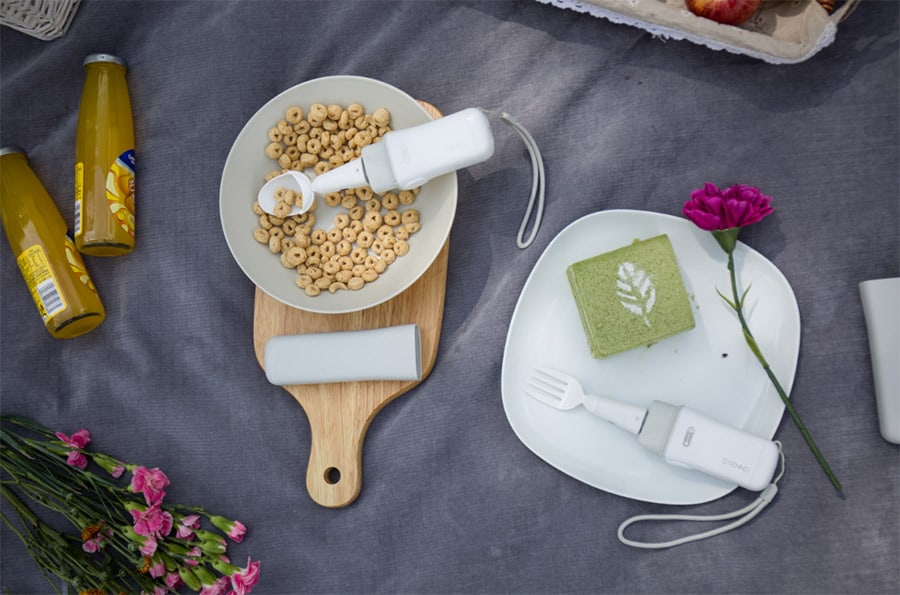
Environment is also a major consideration when assessing for assistive feeding devices as this could straight away rule out the suitability for the client.
Here are some questions that should be asked when booking a joint assessment:
- Where will this product be used?
- Does the client have a dining table?
- If the client is using a wheelchair, can this get close enough to the table?
- Does the client have a height-adjustable table if sitting in an armchair or a lap tray if bed-bound?
- Does the equipment supplier have any alternatives available such as a floor mount or stand?
- Will the product be wheelchair mounted? If so, check the chair specification and suitability.
From previous personal experience as a feeding device representative, these basic questions had not been conversed by the therapist or the product supplier, leading to the appointment being made but delivered unsuccessfully, resulting in wasted valuable time for both the therapist and the equipment supplier. This can also create frustration and disappointment from the potential user of the equipment.
What does the client want from the device socially? Do they like to be fed by a carer or would they prefer to feed themselves?
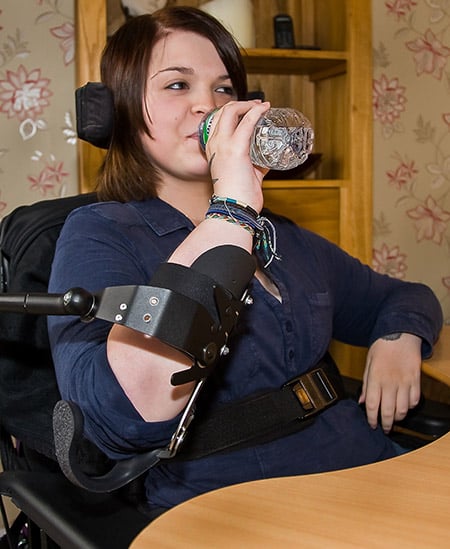
I have a prime example of this from a friend. He is a young man with cerebral palsy. He was considered underweight with reduced energy levels and had depended on being fed by family members for his whole life – over 30 years. He has a wife and two children, and family mealtimes and eating out are extremely important to him.
Prior to receiving his robotic feeding device, he ate very little. He did not enjoy being fed by his wife as he would want her to join the family to eat together. Once being assessed for the product and the product proving successful, he cried with joy! Since using this product, his wife has learned that he has a great appetite, finishes all his meals and has maintained a healthy weight. He now enjoys dining out and feels truly included in his family mealtimes.
Assistive technology has offered this sense of freedom that should be accessible to anyone with a need.
Client suitability is something that should be considered prior to a joint visit for a device. This can be determined via the therapist’s clinical knowledge of the equipment and the technical knowledge of the product representative.
Both the client and product ranges must always be considered:
- What is the user’s range of movement? Do they have head movement or some core strength to lean forward?
- Does the device meet that range of movement to accommodate the client’s ability so they can reach their mouth?
- If the client will be feeding themselves, facilitating their own upper limb movement with spring assistance, do they have bicep strength to bring the food to their mouth?
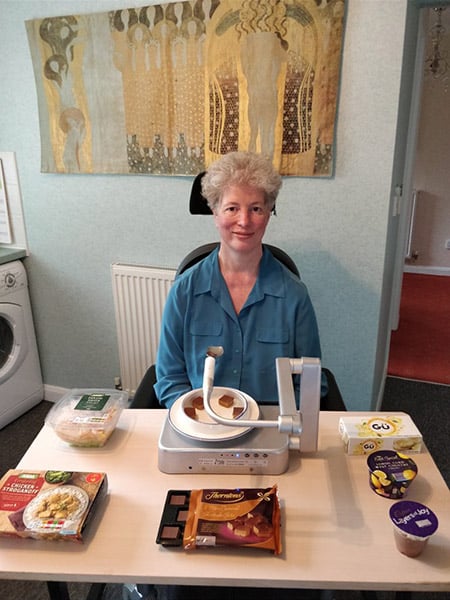
Primarily, if a product consultant has a little clinical background on the client’s ability, they will be aware of the likeliness of its suitability prior to an assessment. All products have a different range and one condition can present entirely different from person to person, so whilst one product may suit one client, it may not suit another with the same condition.
Now that I’ve covered the types of equipment available and the ranges in suitability, routes to funding always create a question mark.
Who is initially responsible for funding this type of equipment?
Initially, the first attempt of funding should be via local authorities as it is usually considered a social need for this type of equipment. However, CCGs and NHS could also evidence this equipment as a health need to avoid malnutrition, which can lead to many further health complications.
If these funding routes are unsuccessful, there are several charities that can aid in funding, particularly if these products are being issued to a child.
Lastly, the client could self-fund by gaining the amount via a social media fundraising platform or by using their own savings. Unfortunately, the latter has become more common over the past couple of years as access to funding for this equipment is surprisingly and quite commonly not granted.
A stronger case would be to joint fund via health and social care. Integration is becoming increasingly important across the country and this positive outcome should deliver a combined social and health need which will deliver the best practice for equipment provision.
For assistive technologies in feeding to be granted, a strong case with justification needs to be submitted to the panel, addressing the specific needs for the equipment. If a product (for example a mobile arm support) can have more than one use, this can build a stronger case as it can assist with more than one ADL (Aspect of Daily Living). The cost of care for feeding should also be considered against the cost of the product.
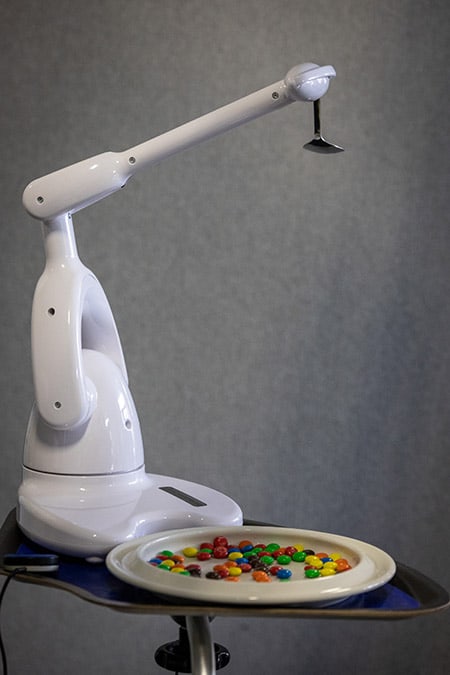
Assistive technology has been proven to reduce care package costs, referenced by the Audit Commissioning Briefing “Fully Equipped 2002 Assisting Independence”. For example, it could reduce a double-handed to a single-handed carer package. On a long-term basis, the cost of a carer for every mealtime should almost certainly outweigh the cost of an assistive feeding device. There are several legislations to support the user with provision of assistive technology, for instance: The Care Act 2014.
Unfortunately, this type of equipment – necessary for delivering independence – is not even considered if there is a family member available to feed them. This is not in the best interest for the client if they do not wish to be fed. Hopefully, the more publications that are raised around this type of equipment, then the greater awareness and consideration it may create!


